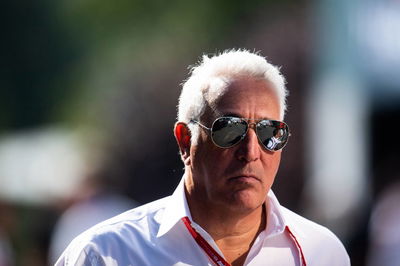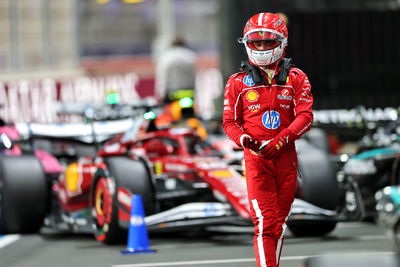From Jordan to Aston Martin via Force India
Aston Martin will return to the Formula 1 grid in 2021, ending a 61-year absence for the British luxury car manufacturer. But how did it get there?
Friday’s announcement that Racing Point will become Aston Martin from the 2021 season in a £182million deal led by Canadian billionaire fashion tycoon Lawrence Stroll signals Aston Martin’s first full-time involvement in F1 since its brief foray during the late 1950s.
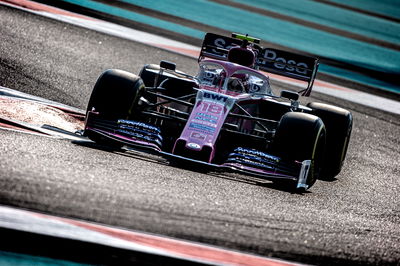
Aston Martin will return to the Formula 1 grid in 2021, ending a 61-year absence for the British luxury car manufacturer. But how did it get there?
Friday’s announcement that Racing Point will become Aston Martin from the 2021 season in a £182million deal led by Canadian billionaire fashion tycoon Lawrence Stroll signals Aston Martin’s first full-time involvement in F1 since its brief foray during the late 1950s.
It also marks the second time the Silverstone-based squad will have rebranded in the space of three years, having gone from Force India to Racing Point prior to its transition into Aston Martin.
Change is nothing new for the team currently known as Racing Point, after undergoing a number of identify variations over the years.
The outfit’s roots and involvement in F1 can be traced back to 1991, when it first entered the championship and competed under the Jordan guise, named after founder Eddie Jordan.
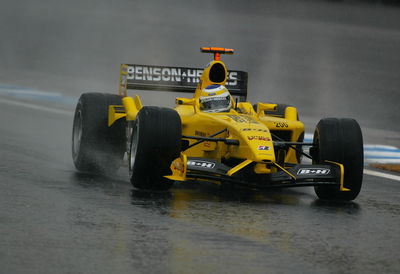
Jordan famously handed a young Michael Schumacher his debut at the 1991 Belgian Grand Prix and claimed four victories and 19 podiums across its tenure under the moniker until 2005, achieving a best result of third in the constructors’ championship during a successful 1999 campaign in which Heinz-Harald Frentzen took third spot in the drivers’ standings.
Financial struggles in the early 2000s led to the team being sold to the Midland Group at the beginning of 2005 for $60million. While the Jordan name remained for 2005, it soon changed to Midland MF1 Racing for 2006.
A change of ownership and identity could not prevent the slump as Midland finished 10th in the 2006 constructors’ championship with zero points to its name, ahead of only Super Aguri.
It was a case of another year and another name change as Dutch firm Spyker bought the team towards the end of 2006, leading to the orange-inspired liveries seen in late 2006 and 2007.
The money troubles continued despite a title sponsorship deal with Etihad Airways. Christijan Albers lost his drive and was released from his contract due to a lack of sponsorship money, while car development also stalled and the team subsequently finished bottom of the constructors’ championship.
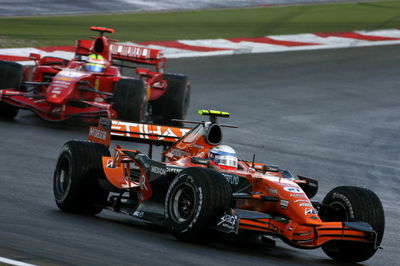
Enter stage left, Vijay Mallya. In October 2007, the Indian businessman bailed the team out of its financial problems by leading a consortium to buyout the Spyker F1 team for €88million, coining the birth of Force India for 2008.
The team switched to compete under an Indian licence but retained the Silverstone headquarters which had served its predecessors. After a tough maiden season in F1 and having endured a 29-race streak without scoring any points, Force India finally got off the mark thanks to memorable performance from the experienced Giancarlo Fisichella (who scored Jordan’s final grand prix win in Brazil 2003) at the 2009 Belgian Grand Prix.
Fisichella stunned the field to claim an unlikely pole position on Saturday at Spa-Francorchamps, before finishing second on the podium behind Ferrari’s Kimi Raikkonen as he achieved three new feats for Force India in the space of 24 hours.
Just like that, and much like the original Jordan squad before it, Force India had established itself as something of a beloved underdog team among F1 fans.
Steady improvements continued from 2010 through 2013, before things really picked up as the V6 hybrid era got underway in 2014. A formidable driver pairing spearheaded by Sergio Perez helped Force India claim sixth, fifth, fourth and fourth again over the following four seasons, with 2017 proving the team’s most successful season to date. Top 10 finishes were regularly expected, while Force India had now become a podium contender.
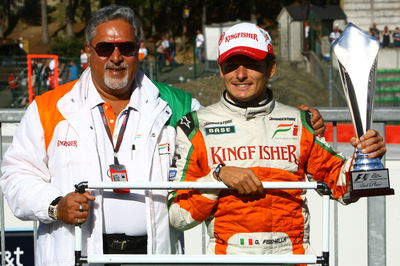
Success may have been found on the track, but troubles looked to be brewing away from the circuit as Mallya’s presence became more and more fleeting. Murmurings of possible financial issues turned serious when it emerged that Mallya was facing extradition and fraud charges with his business empire defaulting on debts.
With Mallya no longer able to afford to run Force India, the team was eventually placed into administration by the High Court in London in July 2018, on the eve of the Hungarian Grand Prix.
This is where Stroll stepped in. The father of then Williams driver Lance Stroll and a consortium of investors saved the Force India entity by buying the assists to create a new entry named Racing Point Force India.
Securing the future of the outfit meant the newly rebranded team could complete the remainder of the season as the new entry started from scratch and still managed to recover seventh in the championship.
The Force India name - which had been an ever-present on the F1 grid since 2008 - ceased to exist heading into the 2019 season when the team changed its constructor entry to Racing Point, dropping the Force India banner altogether as Stroll made the move from Williams to link up with his father’s new squad.
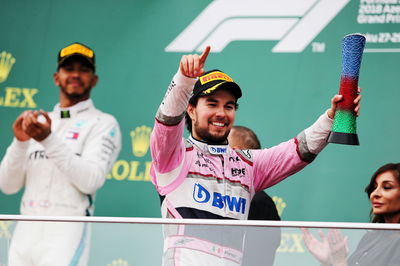
Having rescued the F1 team, Stroll did not wait long to make his next move. As per a report by RaceFans at the back-end of last year, Stroll had been eyeing up a potential buy-in of the ailing Aston Martin firm amid its recent financial struggles.
Stroll’s investment and 20 percent stake in Aston Martin is the first step towards him acquiring a share of the ailing company. Part of Aston Martin’s plans to raise emergency funding worth £500million has resulted in the tie-up with Racing Point, which will see the latest rebrand of the team.
The collaboration is a significant one for both Racing Point and Aston Martin, with the sponsorship running over a four-year period that begins in 2021. In the meantime, Aston Martin will see out its current title sponsorship of the Red Bull team, which will come to a conclusion at the end of this season following an agreement to release the British manufacturer from its F1 exclusivity clause.
The news may well mean that 2020 is the final year of the ‘Pink Panthers’ - with Force India/Racing Point’s cars boasting an eye-catching pink livery since 2017 - before Aston Martin’s presence is felt in 2021.
The deal is a no-brainer for both parties and acts as a statement of intent from Stroll of his vision for Racing Point. After years spent fighting in the midfield, the team has high ambitions of challenging the established top three of Mercedes, Ferrari and Red Bull and fighting for race wins and championships.
While the aim of returning to the higher echelons of the midfield order is perhaps a more realistic short-term target, the upcoming major overhaul to the sporting, technical and financial regulations in 2021 could present Racing Point with its best opportunity to make some serious strides up the pecking order as it embarks on its new journey with Aston Martin.
